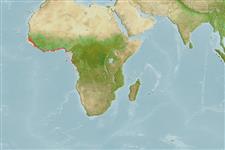>
Eupercaria/misc (Various families in series Eupercaria) >
Lutjanidae (Snappers) > Lutjaninae
Etymology: Lutjanus: Malay, ikan lutjan, name of a fish.
More on author: Bleeker.
Environment: milieu / climate zone / depth range / distribution range
Ecologia
marinhas; estuarina associadas(os) a recifes. Tropical; 13°N - 20°S, 21°W - 17°E (Ref. 55)
Tamanho / Peso / Idade
Maturity: Lm ? range ? - ? cm
Max length : 139 cm TL macho/indeterminado; (Ref. 40637); common length : 50.0 cm TL macho/indeterminado; (Ref. 55); peso máx. publicado: 60.0 kg (Ref. 40637)
Descrição suscinta
Morfologia | Morfometria
Espinhos dorsais (total): 10; Raios dorsais (total): 13-14; Espinhos anais 3; Raios anais : 8. Diagnosis: head pointed; gape of mouth wide (Ref. 57393). Body relatively deep; dorsal head profile straight or somewhat concave; lachrymal bone broad (Ref. 81653). Maxilla extending nearly to mid-eye level (Ref. 55, 57393, 81653). Vomerine tooth plate triangular, sometimes with a short postero-median extension (Ref. 57393, 81653). Preopercular notch and knob weak; pectoral fins of adults not reaching level of anus (Ref. 55, 81653). Scales medium-sized; 5 or 6 transverse scale rows on cheeks (Ref. 57393, 81653). Scale rows on back parallel to lateral line (Ref. 55, 57393, 81653), 4 rows below middle of spinous part of dorsal fin (Ref. 57393, 81653). Reddish brown to slightly orange on back and upper sides, grading to pink or whitish on lower sides and belly; tips of pelvic fins very dark (Ref. 55, 57393, 81653). No blue line on cheeks (Ref. 57393, 81653). Juveniles with a series of about 6 to 8 vertical rows of small white spots or narrow bars on side (Ref. 55, 57393, 81653).
Adults inhabit rocky bottoms and (inshore) coral reefs; also common in brackish lagoons and found in lower courses of rivers, particularly juveniles (Ref. 55, 57393, 81653). Marketed fresh.
Ciclo de vida ou comportamento de acasalamento
Maturidade | Reprodução | Desova | Ovos | Fecundidade | Larvas
Allen, G.R., 1985. FAO Species Catalogue. Vol. 6. Snappers of the world. An annotated and illustrated catalogue of lutjanid species known to date. FAO Fish. Synop. 125(6):208 p. Rome: FAO. (Ref. 55)
Status na Lista Vermelha da UICN (Ref. 130435)
Ameaça para os humanos
Harmless
Uso pelos humanos
Pescarias: pouco comercial; peixe esportivo: sim
Mais informação
Nomes comunsSinônimosMetabolismoPredadoresEcotoxicologiaReproduçãoMaturidadeDesovaAgregação de desovaFecundidadeOvosDesenvolvimento dos ovos
ReferênciasAquaculturaPerfil para aquaculturaEstirpesGenéticaElectrophoresesHereditariedadeDoençasProcessamentoNutrientsConversão de massa
ColaboradoresFotosStamps, Coins Misc.SonsCiguateraVelocidadeTipo de nataçãoÁrea branquialOtólitosCérebrosVisão
Ferramentas
Relatórios especiais
Baixar XML
Fontes da internet
Estimates based on models
Preferred temperature (Ref.
123201): 25.8 - 28, mean 27.5 °C (based on 153 cells).
Índice de diversidade filogenética (Ref.
82804): PD
50 = 0.5000 [Uniqueness, from 0.5 = low to 2.0 = high].
Bayesian length-weight: a=0.01288 (0.00767 - 0.02165), b=2.90 (2.76 - 3.04), in cm total length, based on LWR estimates for this species & Genus-body shape (Ref.
93245).
Nível Trófico (Ref.
69278): 4.0 ±0.66 se; based on food items.
Resiliência (Ref.
120179): Muito baixo(a), tempo mínimo de duplicação da população maior que 14 anos (Preliminary K or Fecundity.).
Fishing Vulnerability (Ref.
59153): Very high vulnerability (83 of 100).
Nutrients (Ref.
124155): Calcium = 16.3 [10.0, 24.2] mg/100g; Iron = 0.248 [0.157, 0.387] mg/100g; Protein = 18.9 [17.4, 20.2] %; Omega3 = 0.122 [0.086, 0.171] g/100g; Selenium = 79.4 [50.1, 122.6] μg/100g; VitaminA = 84.9 [15.3, 311.2] μg/100g; Zinc = 0.404 [0.321, 0.543] mg/100g (wet weight);
